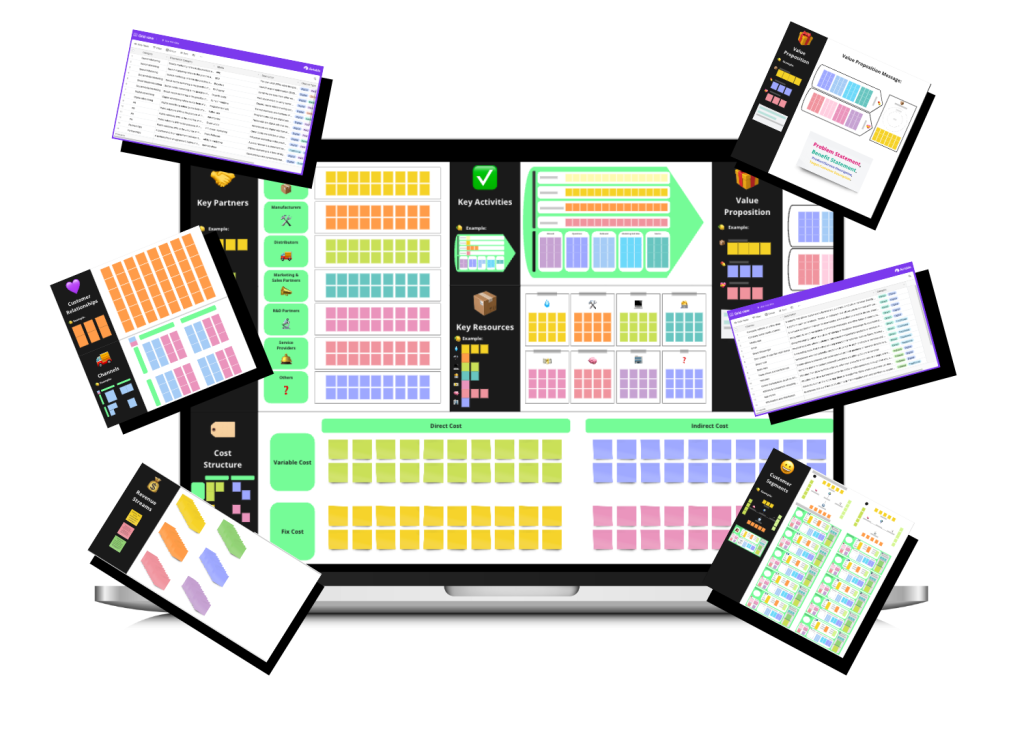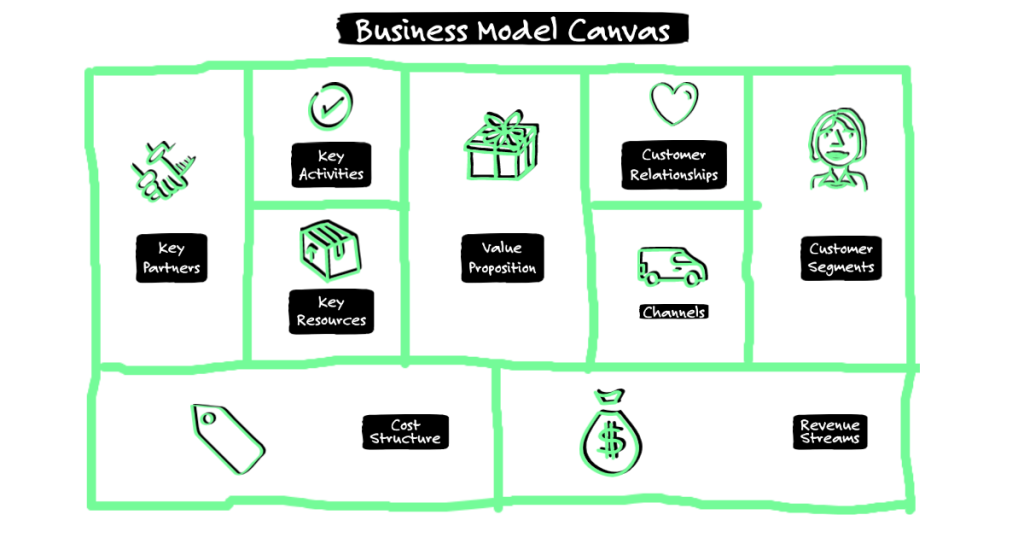💡 What is a Business Model?
In the realm of business strategy, a business model serves as the blueprint for how your company will generate revenue and achieve profitability. The Business Model Canvas, a framework developed by strategyzer, consists of nine building blocks, each representing a crucial element of a business model. These blocks include Value Proposition, Customer Segments, Channels, Customer Relationships, Key Activities, Key Resources, Key Partners, Revenue Streams, and Cost Structure.
🚀 Why is a proper Business Model Definition Important?
Defining a robust business model is crucial, especially for startup founders. It serves as a roadmap that guides decisions, resource allocation, and strategic planning. A well-defined business model not only helps you understand how your company will make money but also provides clarity on essential aspects such as target customers, value proposition, and key activities. By taking the time to outline your business model your will be able to:
- Gain Clarity and Alignment: The Business Model Canvas enables you to clearly articulate and understand key business components in a visual format, fostering a shared understanding regarding value creation.
- Obtain a Holistic View: Breaking down the business into nine essential blocks, the canvas provides a holistic view, facilitating examination of interdependencies among the different elements.
- Work through an Iterative Process: As a dynamic tool, the canvas supports easy modification, crucial for startups iterating on their business model based on evolving insights into customers, market dynamics, and competition.
- Identify Potential Risk and Challenges: The Business Model Canvas helps founders map out the entire business model, allowing them to identify potential risks and uncertainties. This proactive approach enables the development of strategies to mitigate risks and better prepares you for challenges.
- Maintain a Customer-Centric Approach: Focused on customer segments, value propositions, and relationships, the Business Model Canvas encourages a customer-centric approach. It aids you in understanding customer needs and aligning the business model accordingly.
🗒️ Business Model Design Step-by-step
In this guide, we’ll walk you through each field of the Business Model Canvas, breaking down the process step by step. It’s a practical roadmap to help you build a robust and effective business model. This journey provides insights, clarity, and sets the stage for your product/service design and development process. Let’s get started and dive into the nuts and bolts of business model design.
✅ Step A: Value Proposition
- Highlight the Key Aspects of your Value Proposition: Define your Value Proposition by thoroughly analyzing Product/Service Features, emphasizing what sets them apart. Identify Pain Point Solvers, demonstrating a clear understanding of customer needs, and highlight Gain Creators, showcasing the unique benefits your offering provides.
- Formulate your Value Proposition Message: Structure your value proposition message systematically. Begin with a compelling Problem Statement, addressing a specific issue your target customers face. Clearly articulate the Benefit, illustrating how your solution alleviates the problem. Specify the Product/Service Category to provide context, and conclude by outlining the Target Customers, ensuring alignment with their preferences and requirements.
✅ Step B: Customer Segments
- Specify your Customer Segments: Specify which customer segments you are targeting by defining demographic (age, gender), geographic (location), psychographic (lifestyle, values), and behavioral variables (purchasing patterns). This detailed analysis enhances the accuracy of your customer segmentation.
- Create Customer Personas: Go beyond general demographics by utilizing customer persona profiles for each segment. Customer personas are detailed representations of your target audience, including specific characteristics, preferences, and pain points. These profiles provide a humanized understanding of your customers, aiding in personalized marketing and product development.
✅ Step C: Sales & Marketing Channels
- Identify Different Types of Channels: List all the possible channels that you will use to market and sell your offering to your customers, distinguishing between sales and marketing channels. Identify direct/owned channels (e.g. company website, physical stores) and indirect/paid channels (e.g. retailers, online marketplaces).
- Align your Channels with your Audience: Select your channels based on alignment with your business goals. Consider customer preferences and available resources on the Business Model Canvas. This strategic alignment maximizes the impact of your sales and marketing efforts.
✅ Step D: Customer Relationships
- Explore Customer Interactions: Delve into various ways that you will interact with your customers along the user journey. Types of interactions can encompass for example personal assistance, self-service options, automated services, and community engagement etc.
- Tailor Interactions to Customers: Understanding diverse preferences enables the tailoring of customer relationship approaches. Customize your approach based on the preferences of different customer segments. Whether it’s personalized communication, community involvement, or promotions, adapting ensures meaningful and effective interactions.
✅ Step E: Key Activities
- Use the Value Chain Model to Identify the Key Activities: Apply the value chain model to identify and prioritize key activities contributing to value creation. Distinguish between primary activities (core business functions) and support activities (infrastructure, human resources), ensuring a streamlined operational process.
- Identify Contributions: Clearly identify how each key activity contributes to business performance. Whether it’s inbound logistics, operations, outbound logistics, marketing, sales, or services, understanding the role of each activity aids in resource optimization and efficiency.
✅ Step F: Key Resources
- Identify Essential Resources: Identify the essential physical, human, financial, and intangible resources required for delivering value. This includes raw materials, technology, human talent, and intellectual property, basically anything you need to run your business model as well as create and deliver value to your customers.
✅ Step G: Key Partners
- Identify Strategic Alliances: Recognize the significance of strategic alliances and partnerships in creating and delivering value. Identify potential partners in the supply chain, distribution, marketing, research, and development, fostering collaborative relationships.
✅ Step H: Revenue Streams
- Define Income Sources: Clearly define sources of income by exploring various revenue streams. Consider product sales, subscription services, advertising, rental or usage fees, licensing, affiliate revenue, freemium models, consulting, commissions, crowdfunding, and donations. A business also can have several ways of making money, list them all.
✅ Step I: Cost Structure
- Understand your Cost Structure: Think about and not down all the costs your will incur to run your business model, ensuring a comprehensive understanding of the cost structure. This includes both operational costs (utilities, office expenses) and financial costs (interest, depreciation), contributing to effective financial planning.
- Identify Cost Types: Distinguish between direct and indirect costs, as well as variable and fixed costs. Recognize cost elements such as raw materials, labor, rent, marketing, research and development, legal compliance, insurance, taxes, office expenses, professional services, depreciation, interest, and travel.
In conclusion, a well-defined business model is the cornerstone of strategic planning and successful entrepreneurship. By meticulously addressing each building block in the Business Model Canvas, founders can gain clarity, optimize resources, mitigate risks, and effectively communicate their business model to stakeholders. As the foundation for future growth, a robust business model sets the stage for aligning the company’s vision and further development.

Get Ready-to-Use Templates and Practical Guidances . 🚀
Check out our basecamp for founders for practical guidance and templates on Market Environment Analysis and many more business building methodologies.

